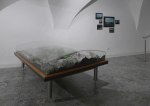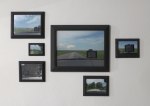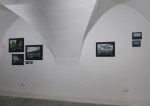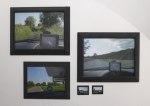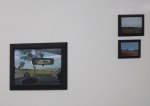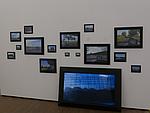Series of photos, 2018/2013
C-Print, wood
The photo series »Framing the Fringe« was developed during a road trip along the eastern borders of the European Union. The center of each photographic image is a conventional navigation device. It serves as a hint that the photograph was taken in front of the respective external border. The landscape around the boundary line provides the background.
The size of each photo-framing corresponds to the length of the external borders of the country where the picture was taken and that way transforms the lengths of the borders (between Estonia-Russia, Lithuania- Kaliningrad, Poland- Kaliningrad, Lithuania-Belarus, Latvia-Russia, Latvia-Belarus, Poland-Belarus, Poland- Ukraine, Romania-Ukraine, Romania-Moldova, Ukraine-Hungary, Slovakia-Ukraine, Bulgaria-Greece, Greece-Turkey) into the dimension of a common format of the exhibition space.
The forests on the borders remain silent, they are green and the wind roams through their leaves and rocks them back and forth cautiously. It is summer. Birds are chirping and bees are humming through the landscape. They follow the scent of the flowers. We now slow down on the little cart road next to the highway. I open the window of the Toyota and take a deep breath. Our speed is now 0.00 km/h, it is 10:58h according to Central European Summer Time and the navigation device asks us to carry on towards Leszno after 3,3 km. The woman's voice still insists several times politely to turn left at the next possibilitiy before we put the device to silence and get out to smoke a cigarette. Around us the grass towers nearly six-foot high and the deciduous trees stand listlessly along the way. We are on the invisible border of the European Union - at the parting line of Poland and Ukraine. We do not want to pass and we are not employees of the European border agency Frontex which patrols the fringes of the European economy carpet with high-tech equipment that should ensure that only invited guests enter the living room. No, we just once want to see with our own eyes how this border of the »better Europe« looks like.
It might have been like that when the artists traveled from Greece across Romania, Hungary, the Slovak Republic as far as Poland and the Baltic states along the eastern external borders of the EU.
Their photographs of this very fringe reveal nothing spectacular. The boundary lines seem to be largely arbitrary in the landscape, only the separation of Estonia and Russia is formed by the natural border of a lake. Nevertheless this fine line that separates different governmental spaces can mean a life, can mean not to be tortured or imprisoned - it can promise the opportunity to learn, to earn, to see his family or just to take part in the good life.
Johanna Tinzl and Stefan Flunger have sought the fringes of the European economic area that separates the EU from the rest of the world and they have put them into picture. On one hand by photographing them through the windshield of the car and on the other hand by translating the respective boundary length into the format of the image the outline; that way a picture of the Hungarian-Ukrainian border, which is 103 km, is much smaller than the image of the Romanian-Ukrainian border with a boundary length of 531 km. The different dimensions of the exhibition's image objects refer thus to the set of intersections of the parted political spaces. The line where the possibility for another life or survival unfold, are caught in the frame that way . At the same time the reflection of the windshield, the tracks on the front glass reduplicate the effect of the picture frame's glass plate and irritate the viewers.
The motives of the color photographs are mostly small roads and narrow lanes lined by run-of-the-mill landscapes: green meadows, flowers and trees under a blue sky with white clouds. They appear almost idyllic beside the standard markings of the infrastructure like signposts, transmission towers and traces of agricultural use.
Nobody can be seen in the photographs. Nevertheless they show the individual as a representative of these landscapes, even more, they show him through an instrument of his domination: in the form of a navigation device that captures every angle of this second nature with satellites.
What serves the artist duo as a guide in the car, represents one of the many technologies that is useful for the control regime on the borders. It makes the walls and the fences that secure the so-called Fortress Europe appear anachronistic so that the humanistic face of Europe does not get threatened to become blemished, while one insults the fences and walls of other countries.
Text: © Katharina Rettelbach
